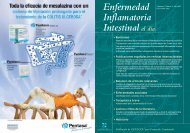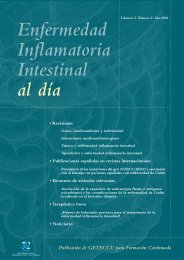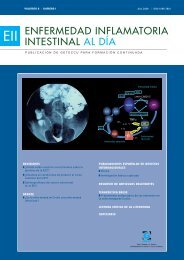Número 3 - EII al dÃa
Número 3 - EII al dÃa
Número 3 - EII al dÃa
- No tags were found...
You also want an ePaper? Increase the reach of your titles
YUMPU automatically turns print PDFs into web optimized ePapers that Google loves.
RESUMEN DE ARTÍCULOS RELEVANTESA. López San RománServicio de Gastroenterología. Hospit<strong>al</strong> Ramón y Caj<strong>al</strong>. Madrid. España.Two-Year Combination Antibiotic Therapy With Clarithromycin,Rifabutin, and Clofazimine for Crohn’s DiseaseTratamiento antibiótico combinado de dos años de duración con claritromicina,rifabutina y clofazimina para la enfermedad de Crohn.Warwick Selby, Paul Pavli, Brendan Crotty, Tim Florin, Graham Radford-Smith, PeterGibson, Brent Mitchell, William Connell, Robert Read, Michael Merrett, Hooi Ee, DavidHetzel y el grupo “Antibiotics in Crohn’s Disease Study Group”Gastroenterology 2007;132:2313–2319Roy<strong>al</strong> Prince Albert Hospit<strong>al</strong>, Sydney, y hasta 20 centros del mismo país (estudio multicéntrico)ResumenSe ha implicado a la bacteria Mycobacterium avium subespecie paratuberculosis (MAP) en la enfermedad de Crohn. Se comunicaun estudio prospectivo y <strong>al</strong>eatorizado doble ciego, comparando el efecto de 2 años de tratamiento anti-MAP (claritromicina,rifabutina y clofazimina, grupo A) con placebo (grupo P) en pacientes con Crohn activo en el momento de la inclusión. Seincluyeron 213 pacientes. Los que llevaban inmunosupresores o mes<strong>al</strong>azina, los mantuvieron. Al principio, todos recibieron unciclo de esteroides (asociado a antibióticos o a placebo) y los respondedores a las 16 semanas continuaron en el estudio. El objetivoprimario fue la proporción de pacientes con recidiva a los 12, 24 y 36 meses.Resultados. A la 16ª semana, la proporción de sujetos en remisión en el grupo A fue significativamente mayor que en el grupoP (66% vs 50%; p=0.02). De los que entraron entonces en la fase de mantenimiento, 39% del grupo A tuvo <strong>al</strong> menos unarecidiva durante el primer año, frente a 56% del grupo P (p=0.054). Tras 2 años de tratamiento, las cifras fueron 26% y 43%,respectivamente (p=0.14). En el tercer año, de seguimiento tras dejar el tratamiento, 59% del grupo A y 50% del grupo P recidivaron(p=0.54).Conclusiones: la combinación de claritromicina, rifabutina y clofazimina durante 2 años no tuvo un efecto beneficioso mantenidoen la enfermedad de Crohn. Se observó mayor respuesta inici<strong>al</strong> a los esteroides en los tratados con antibióticos, pero estopuede ser atribuido a un efecto antibiótico inespecífico. Los datos no apoyan un papel de MAP en la enfermedad de Crohn.SummaryMycobacterium avium subspecies paratuberculosis (MAP) has been implicated in Crohn’s. The authors communicate a prospective,randomized double blind study, comparing the effect of a 2-year therapy against MAP (clarithromycin, rifabutin andclofazimine, group A) or with placebo (group P) in patients with active Crohn’s on inclusion. Patients on mes<strong>al</strong>azine or immunosuppressantscontinued their medications. 213 patients were randomized. At the beginning, <strong>al</strong>l were treated with a courseof steroids (together with antibiotics or with placebo), and the responders at w16 continued the study. The primary endpointwas the proportion of patients with relapse at 12, 24 and 36 months.Results. At week 16, the proportion in remission in group A was significantly higher than in group P (66% vs 50%; p=0.02). Ofthe patients then entering the maintenance phase, 39% in group A and 56% in group P (p=0.054) had at least one relapse duringthe first year. In the third year (follow-up after therapy completion), 59% in group A and 50% in group P relapsed (p=0.54).Conclusions: A combination of clarithromycin, rifabutin and clofazimine for 2 years did not have a sustained benefici<strong>al</strong> effectin patients with Crohn’s. A higher initi<strong>al</strong> response to steroids was observed in patients receiving antibiotics, as compared to patientson placebo, but thios could be attrributed to a nonspecific antibiotic effect. These data do not support a role for MAP inCrohn’s disease.P<strong>al</strong>abras clave: enfermedad inflamatoria intestin<strong>al</strong>, enfermedad de Crohn, micobacterias, paratuberculosis, rifabutina, clofazimina,clarotromicinaKeywords: inflammatory bowel disease, ulcerative colitis, mycobacterias, paratuberculosis, rifabutin, clofazimin, clarithromycin183 • Enfermedad Inflamatoria Intestin<strong>al</strong> <strong>al</strong> día - Vol. 7 - Nº. 2 - 2008











